A Multiswarm Optimizer for Distributed Decision Making in Virtual Enterprise Risk Management
Abstract
We develop an optimization model for risk management in a virtual enterprise environment based on a novel multiswarm particle swarm optimizer called PS2O. The main idea of PS2O is to extend the single population PSO to the interacting multiswarms model by constructing hierarchical interaction topology and enhanced dynamical update equations. With the hierarchical interaction topology, a suitable diversity in the whole population can be maintained. At the same time, the enhanced dynamical update rule significantly speeds up the multiswarm to converge to the global optimum. With five mathematical benchmark functions, PS2O is proved to have considerable potential for solving complex optimization problems. PS2O is then applied to risk management in a virtual enterprise environment. Simulation results demonstrate that the PS2O algorithm is more feasible and efficient than the PSO algorithm in solving this real-world problem.
1. Introduction
Swarm Intelligence (SI) is an innovative artificial intelligence technique for solving complex optimization problems. This discipline is inspired by the collective behaviors of social animals such as fish schools, bird flocks, and ant colonies. In SI systems, there are many simple individuals who can interact locally with one another and with their environments. Although such systems are decentralized, local interactions between individuals lead to the emergence of global behavior and properties.
In recent years, many algorithmic SI methods were designed to deal with practical problems [1–5]. Among them, the most successful is Particle Swarm Optimization (PSO) that drew inspiration from the biological swarming behaviors observed in flocks of birds, schools of fish, and even human social behavior [6–8]. PSO is a population-based optimization tool, which could be implemented and applied easily to solve various function optimization problems. As a problem-solving technique, the main strength of PSO is its fast convergence, which compares favorably with Evolutionary Algorithms (EAs) and other global optimization algorithms [9–12]. However, when solving complex multimodal problems, PSO suffers from the following drawback [13]: as a population evolves, all individuals suffer premature convergence to the local optimum in the first generations. This leads to low population diversity and adaptation stagnation in successive generations. However, such loss of population diversity is not observed in natural systems. Because populations of species interact with one another in natural ecosystems, these species form biological communities which are large social systems typically consist of both heterogeneous and homogeneous aspects. The interaction between species and the complexity of their relationships in these communities exemplify what is meant by the term “symbiosis.” According to different symbiotic interrelationships, symbiotic coevolution can be classified into several categories: mutualism, commensalism, parasitism, and competition. We found that all these types are suitable to be incorporated into the standard PSO model to improve PSO’s performance on complex optimization problems. This should be a general extension of PSO with the purpose of accurately representing as many different forms of symbiotic coevolution as possible.
Thus, inspired by symbiotic cooperation (i.e., mutualism coevolution) phenomenon in nature, this paper proposed a novel multiswarm particle swarm optimizer called PS2O, which extend the single population PSO to interacting multiswarms model by constructing hierarchical interaction topologies and enhanced dynamical update equations. In PS2O, we implement a hierarchical interaction topology that consists of two levels (i.e., individual level and swarm level), in which information exchanges take place permanently. Each individual of the proposed model evolves based on the knowledge integration of itself (associate with individual’s own cognition), its swarm members (associate social interaction within each swarm), and its symbiotic partners from other swarm (associate heterogeneous cooperation between different swarms). That is, we extend the control law (i.e., the dynamic update equation) of the canonical PSO model by adding a significant ingredient, which takes into account the symbiotic coevolution (or heterogeneous cooperation) between different swarms. By incorporating this new degree of complexity, PS2O can accommodate a considerable potential for solving more complex problems. Here we provide some initial insights into this potential by evaluating PS2O on both mathematical benchmark functions and a complex real-world problem-risk management in a virtual enterprise (VE). The 5 benchmark functions used in our experiments have been widely employed by other researchers to evaluate their algorithms [14–16]. In this paper, the risk management problem in VE is modeled as a distributed decision-making (DDM) system. This novel risk management model is a complex hierarchical optimization problem with two levels, namely, the top model and the base model, which take care of the continuous decision variables and the discrete ones, respectively. The simulation results, which are compared to other methods, are reported in this paper to show the merits of the proposed algorithm.
The paper is organized as follows. Section 2 gives a review of the canonical PSO algorithm and several multi-swarm PSO variants. Section 3 describes the proposed multi-swarm coevolution algorithm. In Section 4, it will be shown that PS2O outperforms the canonical PSO and its variants on 5 benchmark test functions. Section 5 describes the risk management optimization model in VE and a detailed design algorithm of risk management by PS2O. The simulation result of risk management in a VE based on PS2O compared with canonical PSO is also presented in this section. Finally, conclusions are drawn in Section 6.
2. Review of Canonical Particle Swarm Optimization
- (i)
its previous best position,
- (ii)
best position of its neighbors.
3. PS2O Algorithm
Straight PSO uses the analogy of a single-species population and the suitable definition of the particle dynamics and the particle information network (interaction topology) to reflect the social evolution in the population. However, the situation in nature is much more complex than what this simple metaphor seems to suggest. Indeed, in biological populations there is a continuous interplay between individuals of the same species, and also encounters and interactions of various kinds with other species [19]. The points at issue can be clearly seen when one observes such ecological systems as symbiosis, host-parasite systems, and prey-predator systems, in which two organisms mutually support each other, one exploits the other, or they fight against each other. For instance, mutualistic relations between plants and fungi are very common. The fungus invades and lives among the cortex cells of the secondary roots and, in turn, helps the host plant absorb minerals from the soil. Another well-known example is the “association” between the Nile crocodile and the Egyptian plover, a bird that feeds on any leeches attached to the crocodile’s gums, thus keeping them clean. This kind of “cleaning symbiosis” is also common in fish.
- (i)
its own previous best position,
- (ii)
best position of its neighbors from its own swarm,
- (iii)
best position of its neighbor swarms.


We should note that, for solving discrete problems, we still use (2.4) and (2.5) to discrete the position vectors in PS2O algorithm. The pseudocode for the PS2O algorithm is listed in Table 1. The flowchart of the PS2O algorithm is presented in Figure 2, and according variables used in PS2O are summarized in Table 2.
| Set t∶ = 0; |
| INITIALIZE. Randomize n swarms each possesses m particles; |
| WHILE (the termination conditions are not met) |
| FOR (each swarm k) |
| Find in the kth swarm neighborhood, the point with the best fitness; |
| Set this point as ; |
| FOR (each particle i of swarm k) |
| Find in the particle neighborhood, the point with the best fitness; |
| Set this point as ; |
| Update particle velocity using (4.1); |
| Update particle position using (4.2); |
| END FOR |
| END FOR |
| Set t∶ = t + 1; |
| END WHILE |
| M | The number of swarms |
| N | Population size of each swarm |
| k | Swarm’s ID counter from 1 to n |
| i | Individual’s ID counter from 1 to m |
| d | Dimension of the problem |
| t | Generation counter from 1 to max generation |
| θ | The index of the best neighbor swarm of the kth swarm |
| The ith individual’s (of the kth swarm) dth dimension’s value | |
| The ith individual’s personal best (of the kth swarm) | |
| The best neighbor position of in the kth swarm | |
| The best neighbor position of the kth swarm |
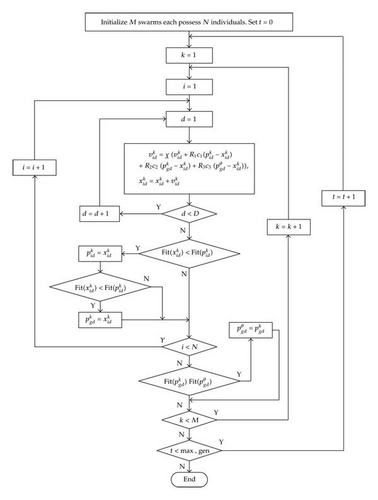
4. Benchmark Test
4.1. Test Function
- (1)
Sphere function:
(4.1) - (2)
Rosenbrock function:
(4.2) - (3)
Griewank function:
(4.3) - (4)
Weierstrass function:
(4.4)where a = 0.5, b = 3, kmax = 20. - (5)
Composition function 1:
(4.5)
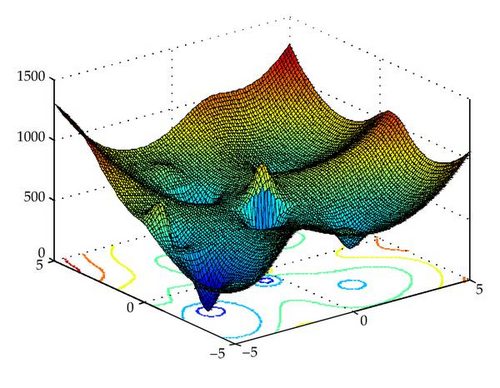
where n is the number of basic function, wi is weight value for each fi(x), fi(x) is ith basic function used to construct the composition function (here f1–f10: Sphere Function), oi is new shifted optimum position for each fi(x), oiold is old optimum position for each fi(x), λi is used to stretch or compress the function, Mi is orthogonal rotation matrix for each fi(x), and biasi is defines which optimum is global optimum.
4.2. Experimental Setting
Among these variations, UPSO combined the global version and local version PSO together to construct a unified particle swarm optimizer; FIPS used all the neighbors’ knowledge of the particle to update the velocity; the FDR-PSO selects one other particle, which has a higher fitness value and is nearer to the particle being updated, to update each velocity dimension.
The number of swarms M needs be tuned. Three 10D functions, namely Sphere, Rosenbrock, and Griewank, are used to investigate the impact of this parameter. Experiments were executed by changing the number of swarms and fixing each swarm size at 10. The average test results obtained form 30 runs are plotted in Figure 4. From Figure 4, we can observe that the performance of PS2O is influenced by M. When M increases, we obtained faster convergence velocity and better results.
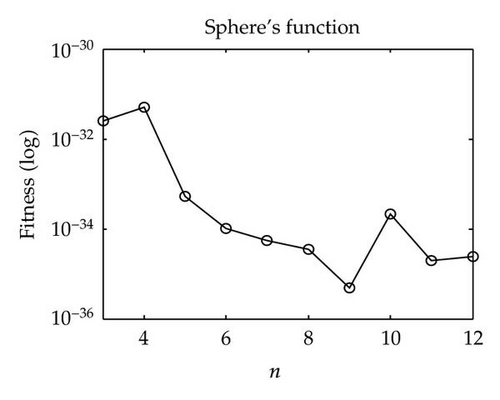
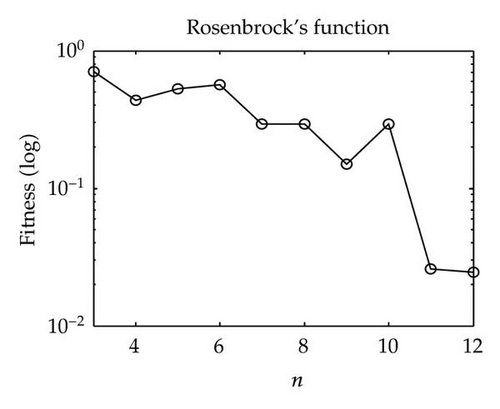
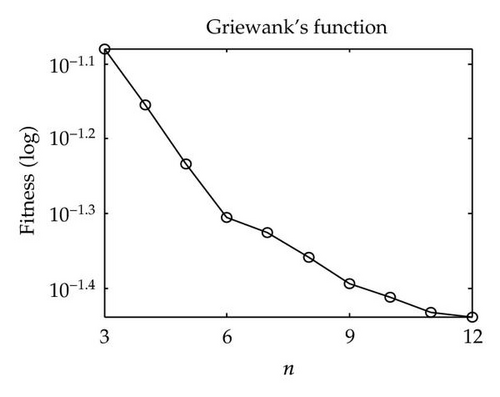
For fair comparison, the population size of all algorithms used in our experiments was set at 100 (all the swarms of PS2O include the same particle numbers of 10). The maximum velocity of all PSO variants was set to be 5% of the search space for unimodal functions and 50% for multimodal functions. For canonical PSO and UPSO, the learning rates c1 and c2 were both 2.05 and the constriction factor χ = 0.729. For FIPS, the constriction factor χ equals 0.729 and the U-ring topology that achieved highest success rate is used. For FDR-PSO, the inertia weight ω started at 0.9 and ended at 0.5 and a setting of c1 = c2 = 2.0 was adopted. For PS2O, the interaction topology illustrated in Figure 1(b) is used; the constriction factor in PS2O is also used with χ = 0.729 according to Clerc’s method; correspondingly, the ϕ coefficient must sum to 4.1 and then the learning rates c1 = c2 = c3 = ϕ/3 ≈ 1.3667.
4.3. Simulation Results
The experiment runs 50 times, respectively, for each algorithm on each benchmark function of 30 dimensions. The numbers of generations were set to be 10000. The representative results obtained are presented in Table 4, including the best, worst, mean, and standard deviation of the function values found in 50 runs. Figures 5, 6, 7, 8, and 9 presents the evolution process for all algorithms according to the reported results in Table 3.
| Func. (dim.30) | PS2O | CPSO | FIPS | UPSO | FDR-PSO | |
|---|---|---|---|---|---|---|
| f1 | Best | 0 | 2.4787e − 116 | 1.1874e − 030 | 3.4459e − 185 | 6.9665e − 190 |
| Worst | 0 | 1.3486e − 113 | 9.7762e − 029 | 1.9929e − 182 | 7.4365e − 168 | |
| Mean | 0 | 2.4205e − 114 | 1.7391e − 029 | 3.7072e − 183 | 2.4789e − 169 | |
| Std | 0 | 3.3966e − 114 | 2.2995e − 029 | 0 | 0 | |
| f2 | Best | 1.5203e − 015 | 5.8889 | 17.4217 | 0.7070 | 0.0012 |
| Worst | 5.1336e − 014 | 7.4375 | 23.4450 | 4.0368 | 4.0879 | |
| Mean | 1.0412e − 014 | 6.6172 | 22.5407 | 2.0983 | 0.2797 | |
| Std | 9.7087e − 015 | 0.4028 | 1.2748 | 0.7696 | 1.0224 | |
| f3 | Best | 0 | 0 | 0 | 0 | 0 |
| Worst | 0 | 0.1152 | 0.0123 | 0.0388 | 0.0737 | |
| Mean | 0 | 0.0183 | 0.0016 | 0.0347 | 0.0179 | |
| Std | 0 | 0.0266 | 0.0038 | 0.0478 | 0.0182 | |
| f4 | Best | 0 | 2.8242e − 005 | 0 | 0 | 0 |
| Worst | 0 | 3.7591 | 0.2856 | 8.1054 | 1.5086 | |
| Mean | 0 | 1.3510 | 0.0201 | 4.4244 | 0.1581 | |
| Std | 0 | 1.1606 | 0.0558 | 2.6022 | 0.4569 | |
| f5 | Best | 0 | 0.0051 | 0 | 0 | 0 |
| Worst | 0 | 100.0071 | 45.5672 | 0.0467 | 300.00 | |
| Mean | 0 | 50.0061 | 33.7051 | 0.0136 | 100.00 | |
| Std | 0 | 70.7121 | 25.8645 | 0.0143 | 141.42 | |
| Value of risk probability | Risk level |
|---|---|
| [0.00, 0.38] | Low risk |
| (0.38, 0.67] | Medium risk |
| (0.67, 1.00] | High risk |
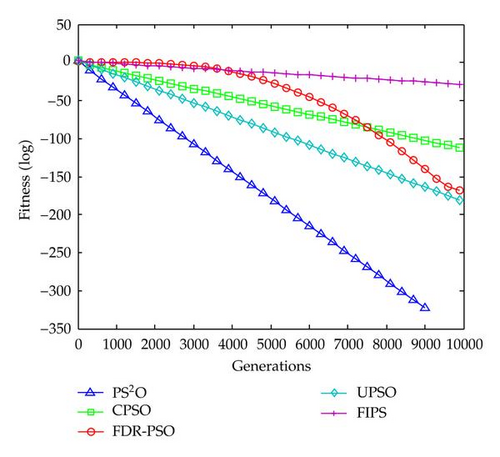
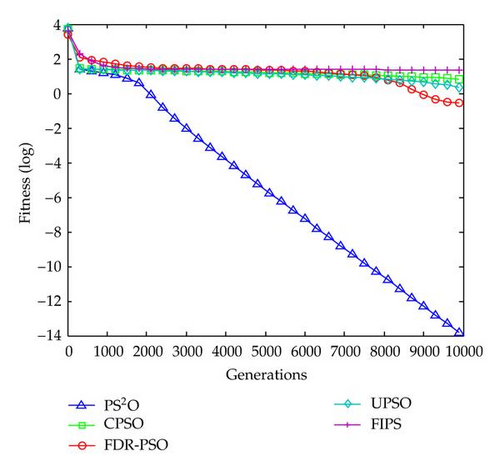
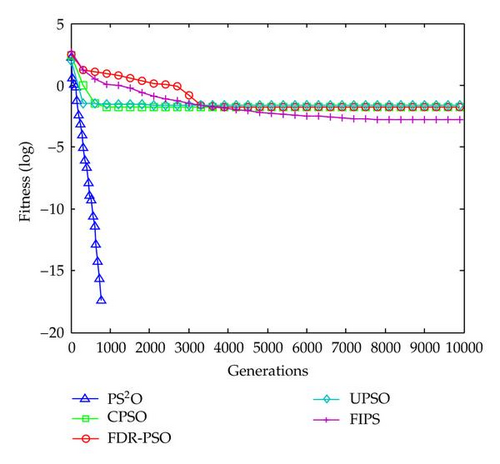
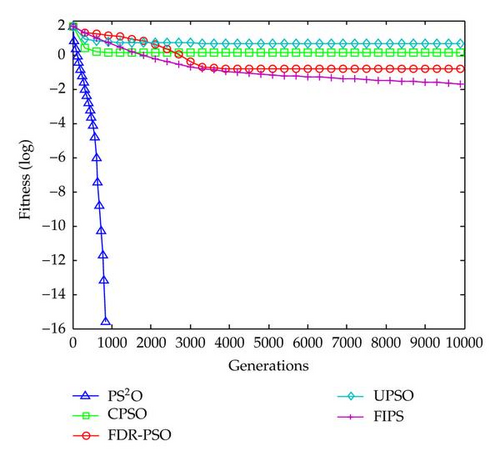
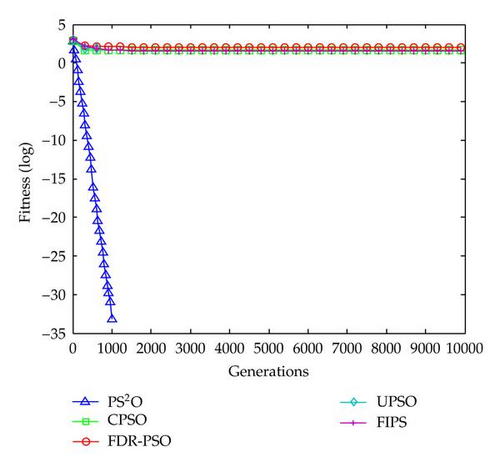
From the results, we can observe that the PS2O algorithm obtains an obviously remarkable performance. We can see it clearly that PS2O converged with greatly faster speed to significantly better results than the other PSO variants for both unimodal and multimodal cases. It should be mentioned that the PS2O were the only ones able to consistently find the minimum of the Sphere function, Griewank’s function, Weierstrass function, and Composition function 1, while the other algorithms generated poorer results on them. The result on Rosenbrock obtained by PS2O is also very good. Since a result within 40.0 on 30 D Rosenbrock reported in other EA and SI works is considered well, the PS2O algorithm’s performance on Rosenbrock function is remarkable good.
With the hierarchical interaction topology, a suitable diversity in the whole population can be maintained. At the same time, the enhanced dynamical update rule significantly speeds up the multi-swarm to converge to the global optimum. Because of this, the PS2O performs considerably better than many PSO variants.
5. Virtual Enterprise Risk Management Based on PS2O
A virtual enterprise (VE) [25] is a temporary consortium of autonomous, diverse, and possibly geographically dispersed organizations that pool their resource to meet short-term objectives and exploit fast changing market trends. A VE is a dynamic alliance of member companies (owner and partners), which join to take advantage of a market opportunity. Each member company will provide its own core competencies in areas such as marketing, engineering, and manufacturing to the VE. When the market opportunity has passed, the VE is dissolved. In a VE environment, there are various sources of risks that may threaten the security of VE, such as market risk, credit risk, operational risk, and others [26]. Recently, risk management of a VE has attracted much research attention.
5.1. The Two-Level Optimization Model for Risk Management in a Virtual Enterprise
In this paper, the two-level risk manage model suggested by Huang and Lu [27] is employed to evaluate the performance of the proposed PS2O algorithm. This model can be described as a two-level Distributed Decision Making (DDM) system that is depicted in Figure 10(a).
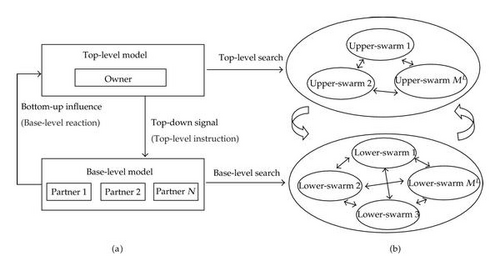
5.2. Risk Management in VE Based on PS2O
The detailed design of risk management algorithm based on PS2O is introduced in this section. Since the optimizing problem has a two-level hierarchical structure, this risk management algorithm is composed of two types of swarms that search in different levels, respectively, namely, the upper swarm and the lower swarm. The algorithm design reflects a two-phase searching process as Figure 10(b) illustrates. In the top-level searching process, the upper swarms that are designed based on the continuous PS2O, search a continuous space for the investment budget allocation for all VE members. While the lower swarms, which are designed based on the discrete PS2O, receive information from upper swarms, and must search the discrete space for a best action combination for risk management of all partners. The overall searching process can be described as follows.
(1) Particle Representation
(a) Definition of Continuous Particle In each upper-swarm, each particle has a dimension equal to n + 1 (i.e., the number of VE members). Each particle has a real number representation and is a possible allocation of investment budget for all members. The ith particle of the kth upper swarm is defined as follows:
For example, a real-number particle (286.55, 678.33, 456.78, 701.21, 567.62) is a possible allocation of investment budget of 5 VE members. The first bit means that the owner received investment of 286.55 units. The 2 to 5 bits mean that the amount of investment allocated to partner 1 to 4 is 678.33, 456.78, 701.21, and 567.62 respectively.
(b) Definition of Discrete Particle For the lower swarms, in order to appropriately represent the action combination by a particle, we design an “action-to-risk-to-partner” representation for the discrete particle. Each discrete particle in each lower swarm has a dimension equal to the number of n × m × W, here W is the number of available actions for each risk factor, m is the number of risk factors of each partner, and n is the number of VE partners. The ith particle of the kth lower swarm is defined as follows:
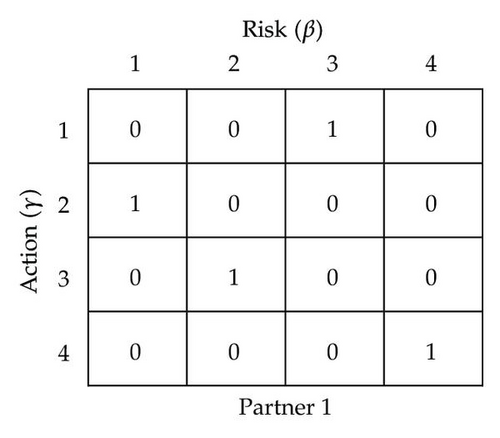
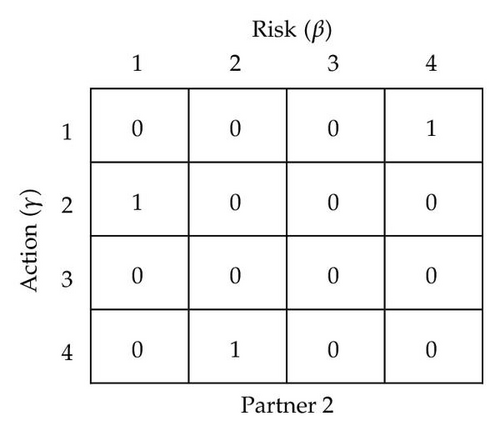
(2) Risk Management Procedure The processing performed by this algorithm is best illustrated in the diagram given in Figure 12.
Step 1. The first step in top level is to randomly initialize MT upper swarms each possesses NT particles (totally MT × NT individuals). Each particle in the top level is an instruction and is communicated to the base level to drive a base level search process (Steps 2–4).
Step 2. For each top-level instruction , the base-level randomly initialize MB lower swarms each possesses NB particles (totally MB × NB individuals). At each iteration in base level, for each particle (i.e., the ith particle of the kth lower-swarm), evaluate its fitness using the base-level optimization function as follows:
Step 3. Compare the evaluated fitness values and select pbest, sbest, and cbest for each lower swarm. Then update the velocity of each base level particle according to (3.1). For our problem, each partner can only select one action for each risk factor or do nothing with this factor. In order to take care of this problem, for each particle, action γ is selected for risk factor β of partner α according to following probability:
Step 4. The base-level search process is repeated until the maximum number of base-level iteration is met. Then send the last best base-level decision variable to the top-level for the fitness computation of the top-level particle .
Step 5. With the base-level reaction , each top-level particle is evaluated by the following top-level fitness function:
-
Algorithm 1
-
Begin
-
Let Xtemp be a zero vector that has a dimension equal to n × m × W.
-
For (α = 1 to n)
-
For (β = 1 to m)
-
For (γ = 1 to W)
-
If (rand ≤ pi(αβγ)k)
-
//Action γ is selected for risk β of partner α
-
;
-
Break;
-
End if
-
End for
-
End for
-
End for
-
-
END
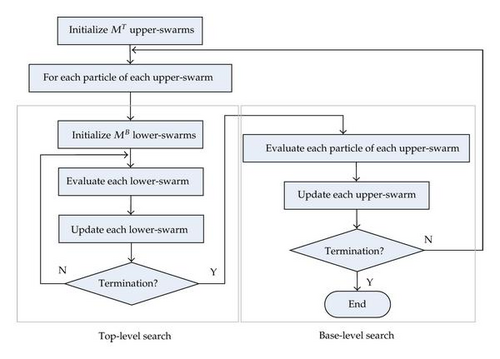
5.3. An Illustrative Example
In this section, a numerical example of a VE is conducted to validate the capability of VE risk management based on the proposed PS2O. In order to show the superiority of PS2O, the risk management algorithm designed by canonical PSO is also applied to the same case.
In this case, the VE is constructed by one owner and four partners (i.e., n = 4) and the total investment is Bmax = 3500; 10 risk factors are considered for each partner and 4 actions can be selected for each risk factor (i.e., m = 10 and W = 4); the number of risk ratings l = 3 and the value of each rating is d1 = 0.165, d2 = 0.335, and d3 = 0.500, respectively (according to the values of ratings, the criterion of risk rating is shown in Table 4); the maximum risk level Rmax = 0.67, which means that the risk level of each member must be below the medium level; the weight of risk level of each VE member is w0 = w1 = w2 = w3 = w4 and the weights uβ of each risk factors for each partner are listed in Table 5; the values of the parameter θβλ and are presented in Tables 6 and 7, respectively; the punishment coefficient ϕ, η, and φ are given as 1.5, 28 and 0.2.
| Risk factor | 1 | 2 | 3 | 4 | 5 | 6 | 7 | 8 | 9 | 10 |
|---|---|---|---|---|---|---|---|---|---|---|
| uβ | 0.1 | 0.15 | 0.10 | 0.05 | 0.10 | 0.10 | 0.15 | 0.10 | 0.05 | 0.10 |
| β | λ | ||
|---|---|---|---|
| 1 | 2 | 3 | |
| 1 | 0.10 | 0.07 | 0.13 |
| 2 | 0.23 | 0.20 | 0.17 |
| 3 | 0.33 | 0.27 | 0.30 |
| 4 | 0.37 | 0.40 | 0.43 |
| 5 | 0.50 | 0.47 | 0.53 |
| 6 | 0.63 | 0.57 | 0.60 |
| 7 | 0.73 | 0.70 | 0.67 |
| 8 | 0.83 | 0.77 | 0.80 |
| 9 | 0.87 | 0.90 | 0.93 |
| 10 | 1.00 | 0.97 | 1.03 |
| Risk factor | 1 | 2 | 3 | 4 | 5 | 6 | 7 | 8 | 9 | 10 |
|---|---|---|---|---|---|---|---|---|---|---|
| 0.1 | 0.2 | 0.3 | 0.4 | 0.5 | 0.6 | 0.7 | 0.8 | 0.9 | 1.0 |
In applying PS2O and PSO to this case, the continuous and binary algorithms are used in top level and base level of the optimization model respectively. For the top-level algorithms, the maximum generation in each execution for each algorithm is 100; the initialized population size of 10 particles is the same for PS2O and PSO, while the whole population is divided into 2 swarms (each possesses 5 individuals) for PS2O in the initialization step; the interaction topology illustrated in Figure 1(a) is used for continuous PS2O; the other parameters of continuous PS2O and PSO were set to the same values as in Section 4. For the base-level algorithms, the maximum generation for each algorithm is 100; the initialized population size of 20 particles is the same for PS2O and PSO, while the whole population is divided into 4 swarms (each possesses 5 individuals) for PS2O in the initialization step; the interaction topology illustrated in Figure 1(b) is used for binary PS2O; the other parameters of binary PS2O and PSO were set to the same values as in Section 4. The experiment runs 30 times, respectively, for each algorithm.
The top-level and base-level search progresses of the averaged best-so-far fitness values over 20 runs are shown in Figures 13 and 14, respectively. It should be noted that the total iteration of base-level searching is 100 (base-level maximum generation) ×10 (top-level population size) ×10 (top-level maximum generation) = 104. That is, the base-level algorithms will be restarted after every 100 iterations. From the figures, we can see that PS2O converges with a higher speed compared to PSO and obtains better results in both levels searching progresses.
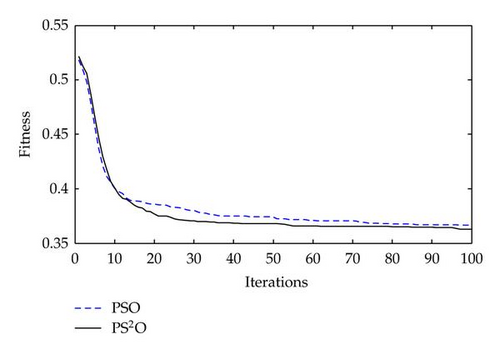
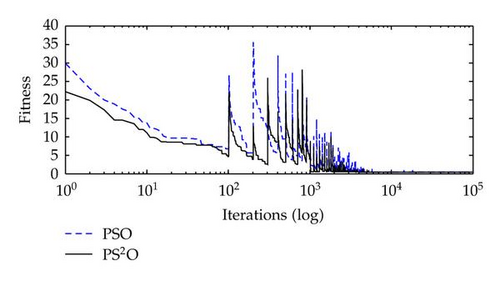
The average solutions over 30 runs obtained by PS2O and PSO are summarized in Table 8. Before proceeding with the risk management procedure, the risk levels are one for both the VE and the partner, which is a high risk level. Table 8 shows that the resulting risk levels of the VE and the owner are in the low risk level, while all the partners are in the medium risk level. Therefore the budget and the actions selected by the owner and the partner are very effective to reduce the risk of the VE.
| Value of risk probability | PSO | PS2O |
|---|---|---|
| Risk level of VE | 0.3667 | 0.3628 |
| Risk level of owner | 0.2268 | 0.2340 |
| Risk level of partner | 0.6191, 0.6172, 0.6006, 0.6285 | 0.6148, 0.6180, 0.5694, 0.5751 |
| Total budget | 3.4455e + 003 | 3.4223e + 003 |
| Each member’s budget | 754.12, 670.47, 693.35, 674.78, 652.81 | 734.17, 668.18, 673.69, 684.84, 661.39 |
To fully demonstrate the risk management performance using the PS2O algorithm, risk investment budget, and risk level controlling processes of each VE member based on PS2O is shown in Figure 15. Generally, an effective actions sequence corresponds to a higher cost and a lower risk level. From the figures, it can be concluded that the additional cost of selecting effect actions can not result in a remarkable decrease in the risk level.
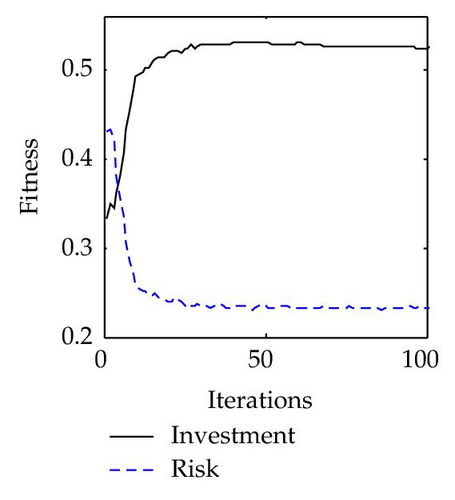
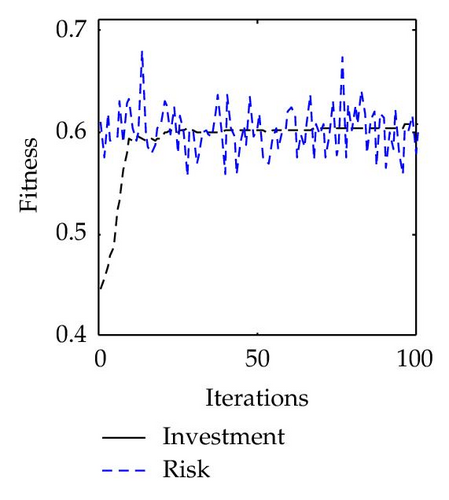
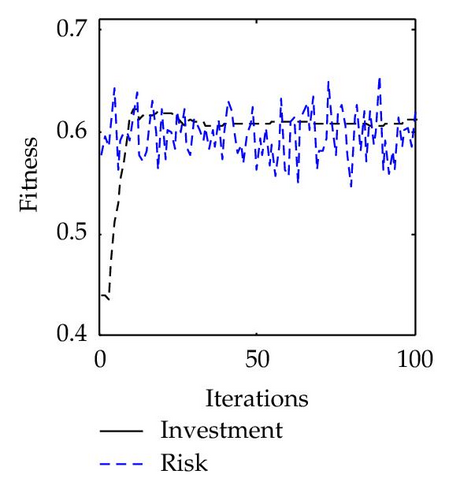
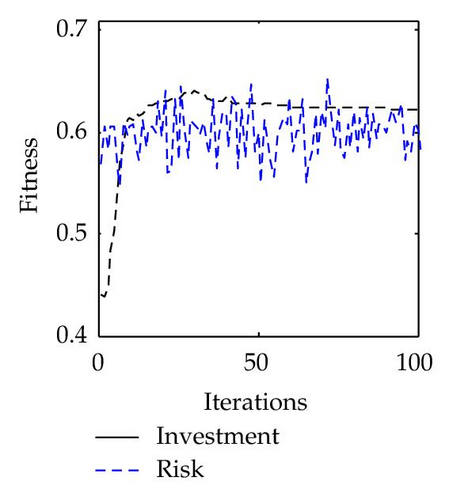
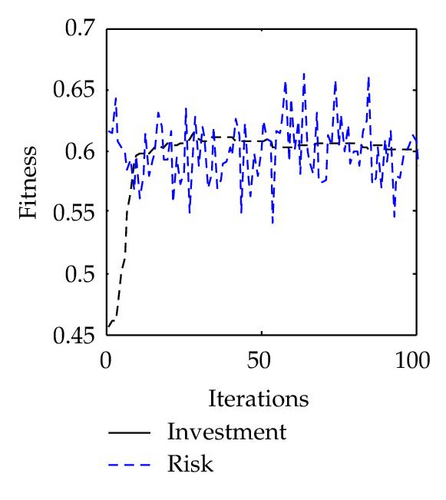
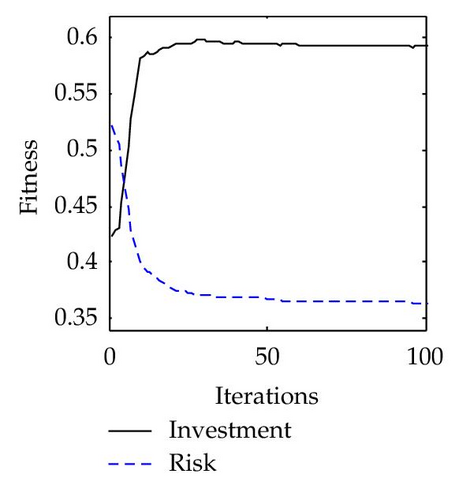
6. Conclusions
In this paper, we develop an optimization model for minimizing the risks of the virtual enterprise based on a novel multi swarm optimizer PS2O. In PS2O, the hierarchical interaction topology consists of two levels (i.e., the individual level and the swarm level), in which information exchanges take place not only between the particles within each swarm but also between different swarms. The dynamical update equations of our multi-swarm approach are enhanced by a significant ingredient, which takes into account the symbiotic coevolution (or heterogeneous cooperation) between different swarms. Because of this, each individual of the proposed model evolves based on the knowledge integration of itself (associate with individual’s own cognition), its swarm members (associate social interaction within each swarm), and its symbiotic partners from other swarm (associate heterogeneous cooperation between different swarms). With five mathematical benchmark functions, PS2O is proved to have significantly better performance than four successful variants of PSO.
In the proposed risk management model of VE, a two-level optimization scheme was introduced to describe the decision processes of the owner and the partners. This DDM model considers the situation that the owner allocates the budget to each member of the VE in order to minimize the risk level of the VE. Accordingly, a transfer optimization model, which can easily use EA and SI algorithms to treat the risk manage problem in VE, is elaborately developed. PS2O is then employed to solve the real-world VE risk management problem. The simulation studies, which compared to Canonical PSO algorithm, show that the PS2O obtains superior risk management solutions than PSO methods in terms of optimization accuracy and convergence speed.
Acknowledgments
This work is supported by the Natural Science Foundation of Liaoning Province of China under Grant 20082006, the Support Program for the Outstanding Technological Person in Liaoning Province of China under Grant lr2011035, and the National Natural Science Foundation of China under Grants 61105067 and 61174164.




